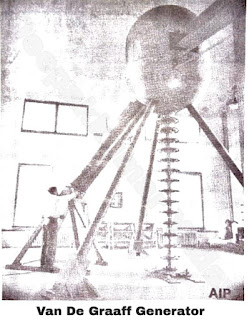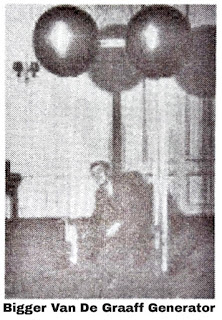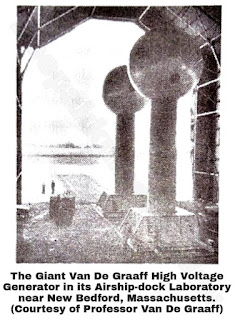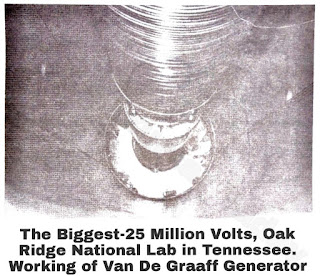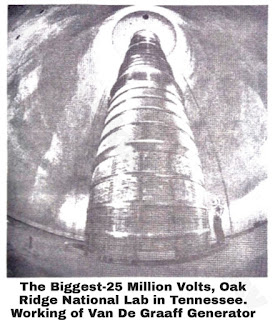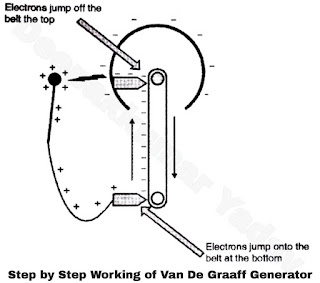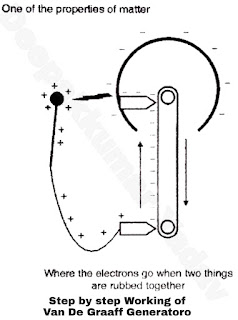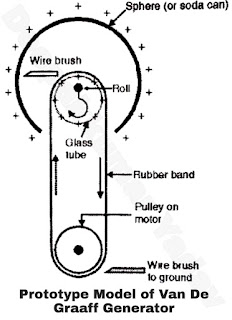Van de Graaff Generator
Q. With a neat sketch, explain the working of a Van-De-graff generator. What are the factors that limit the maximum output voltage obtained ?
- A Van de Graaff generator is a device that creates high electric potential.
- The Van de Graff generator was invented by Robert J. Van de Graaff, and American physicist (1901 – 1967).
- Van de Graaff generators can produce electric potentials up to many 10s of millions of volts.
- Van de Graaff generators can be used to produce particle accelerators.
- We have been using a Van de Graaff generator in lecture demonstrations and we will continue to use it.
Working Principle of Van de Graaff Generator :
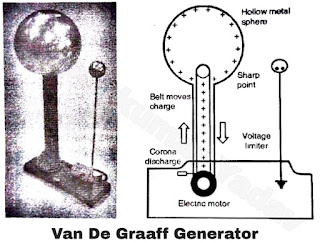 |
| Figure A |
- The Van de Graaff generator work by applying a positive charge to a non conducting moving belt using a corona discharge.
- The moving belt driven by an electric motor carries the charge up into a hollow metal sphere where the charge is taken from the belt by a pointed contact connected to the metal sphere.
- The charge that builds up on the metal sphere distributes itself uniformly around the outside of the sphere.
- For this particular Van de Graaff generator, a voltage limiter is used to keep the Van de Graaff generator from producing sparks larger than desired.
- Friction between acrylic roller and rubber belt.
- Lower comb sprays on negative charge by induction.
- Upper comb sprays positive charge to leave negative charge on dome.
- Millions of volts achievable in dry conditions.
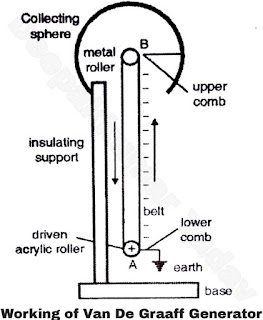 |
| Figure B |
- Rubber band steals electrons from glass.
- Glass becomes positively charged.
- Rubber band carries electrons downward.
- Positively charged glass continues to rotate.
- Wire “brush” steals electrons from rubber band.
- Positively charged glass steals electrons from upper brush.
- Sphere (or soda can) becomes positively charged to 20,000 volts.
Figure J
Power Required to move the Belt
- An insulated belt is moving with uniform velocity v in an electric field of strength E (x). Suppose the width of the belt is b and the charge density consider a length dx of the belt, the charge dq = σbdx
- The force experienced by this charge (or the force experienced by the belt) is given by,
dF = Edq = E σbdx or F = σb ∫Edx
Since the electric field is uniform, therefore,
F = σ bv
The power required to move the belt –
= Force x Velocity
= F v = abVv
Now, I = dq/dt = ob (dx/dt)
Therefore 1 = σ bv
Hence Power required to move the belt is
P = F v = σ bVv = VI
Advantages of Van de Graaff Generator :
- Very high voltages can be easily generated.
- Ripple free output.
- Precision and flexibility of control.
Disadvantages of Van de Graaff Generator :
- Low current output.
- Limitations on belt velocity due to its tendency for vibration. The vibrations may make it difficult to have an accurate grading of electric fields.
Applications of Van de Graaff Generator :
- The beam of these charged accelerated particles is used to trigger the nuclear reaction.
- Accelerated particle beams are used to break atoms for various experiments in physics.
- In medicine, such beams are used to treat cancer.

